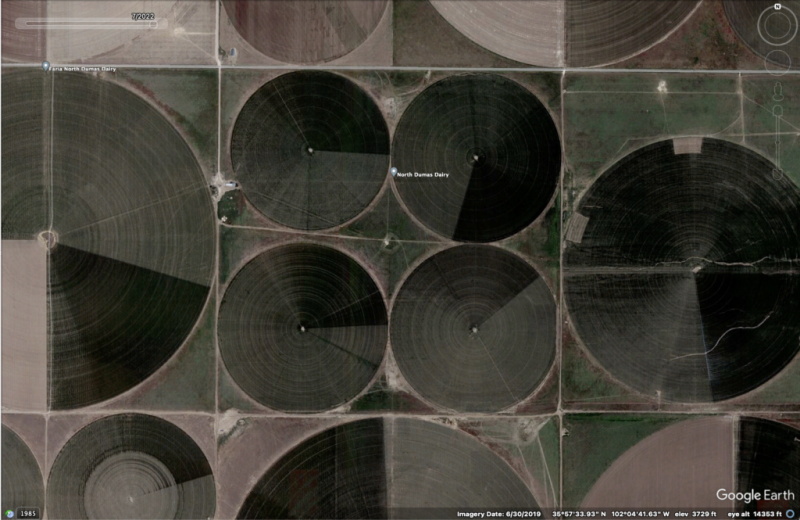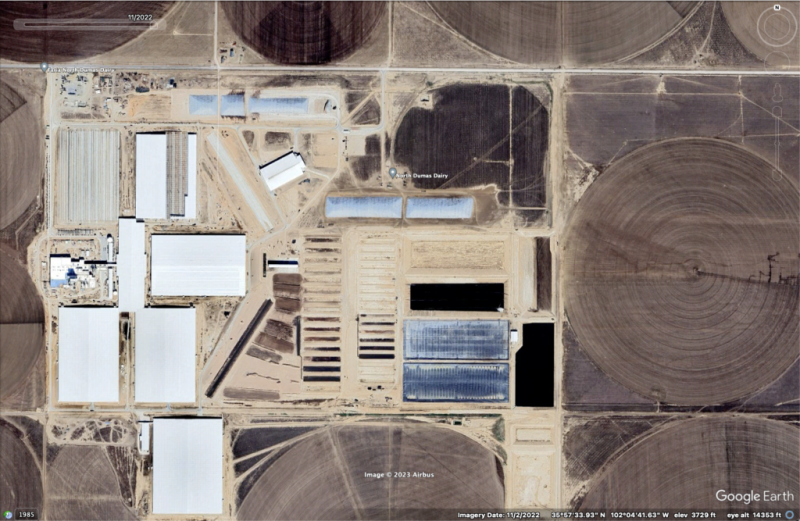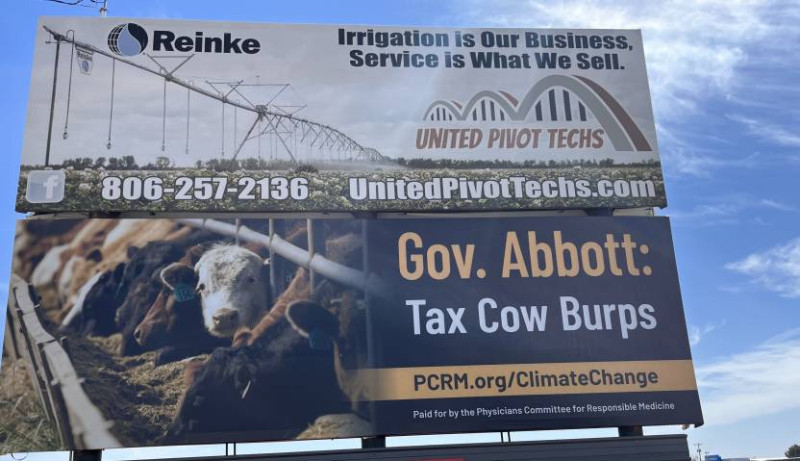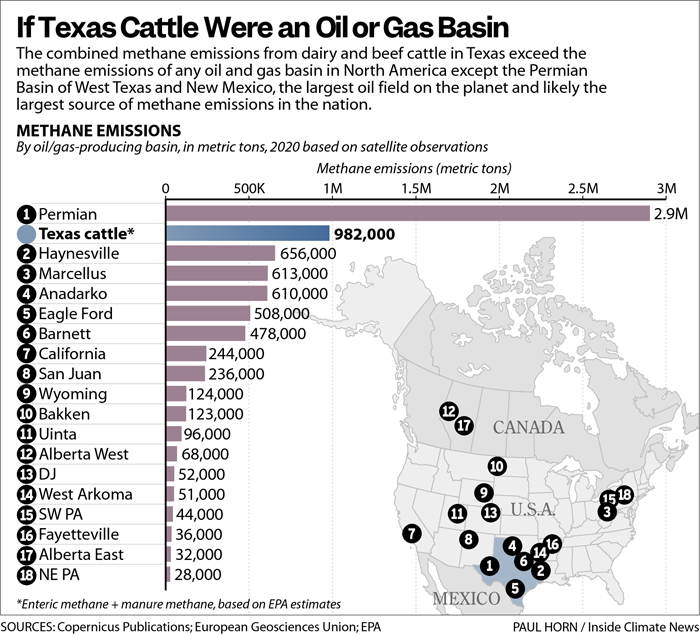A Texas Dairy Ranks Among the State’s Biggest Methane Emitters. But Don’t Ask the EPA or the State About It
Three years ago, North Dumas Farms was an empty field near the northern edge of the Texas Panhandle. Today it is a massive dairy operation—and one of the largest greenhouse gas emitters in the state.
The dairy is permitted to hold up to 72,500 cows, whose burps and manure would produce an estimated 13,096 metric tons of methane each year, according to an Inside Climate News analysis of data from the Texas Commission on Environmental Quality.
This analysis builds on the pioneering work of Climate TRACE, a nonprofit coalition that is developing methods to provide a farm-by-farm inventory of methane emissions from cattle based on public records, satellite imagery and artificial intelligence.
Methane is a potent greenhouse gas that on a pound for pound basis is 81 times more effective at warming the earth’s atmosphere than carbon dioxide over a 20-year period. If all of the methane produced by the North Dumas dairy entered the atmosphere, the farm’s annual greenhouse gas emissions would equal that of nearly a quarter-million automobiles.
Methane’s potency as a greenhouse gas combined with its short lifetime—methane remains in the atmosphere for just 12 years—means that curbing emission of the gas is the single best way to combat climate change in the short term, according to the United Nations’ Intergovernmental Panel on Climate Change, or IPCC.
Nationwide, cows collectively emitted more than twice as much methane from their burps and manure as all oil and gas wells combined, including those active or abandoned, onshore or offshore, in 2020, according to an Inside Climate News assessment of data in the Environmental Protection Agency’s 2022 Inventory of U.S. Greenhouse Gas Emissions.
But you won’t find North Dumas Farms, or any other American dairy or livestock operation, in any government greenhouse gas database.


Four years ago the North Dumas Farms was an empty farm field, as shown in the photo on the left, which was made on June 30, 2019. Today, it is one of the largest dairies in Texas, permitted to hold up to 72,500 cows. The photo on the right shows the dairy on November 2, 2022. Credit: Google Earth
The EPA’s Greenhouse Gas Reporting Program, which was established in 2007 to provide detailed accounting, facility by facility, on emissions from “all sectors of the U.S. economy,” exempts agriculture.
And the Texas Point Source Emissions Inventory, an annual state survey of large, industrial polluters, excludes greenhouse gases altogether. In a state increasingly threatened by droughts, heat waves, and more frequent and intense storms linked to climate change, there is little information about methane from cattle.
While better known as a beef-producing state, with nearly twice the number of beef cattle as any other state, Texas has rapidly expanded its dairy production in recent decades. Today it is the nation’s third-largest dairy producer, and in north Texas, where the state industry is concentrated, the number of dairy cows increased “by a whopping 3,500% from 1995 to 2015,” according to a recent report by the Texas House Committee on Agriculture & Livestock. That means there were 36 times as many cows in the region in 2015 as there were 20 years earlier.
This presents a monumental problem as the nation begins mustering the resolve to rein in climate change. “If we’re going to achieve net-zero [emissions], we have to be addressing all our gases, from all our sources,” said Katharine Hayhoe, an atmospheric scientist at Texas Tech University and the chief scientist for the Nature Conservancy, referring to the Biden administration’s target for 2050. “We have to know where all our emissions are coming from.”
The EPA excluded methane emissions from cows when it launched its greenhouse gas reporting program in 2009, stating that “the methodologies are uncertain, variable and burdensome for reporters.”
For decades, environmental advocacy organizations have submitted public records requests and filed lawsuits against the EPA in a quest for this data but have been thwarted in compiling even basic information on the location and size of large industrial farms in most states.
This is the void that Climate TRACE, a coalition of organizations co-founded by former Vice President Al Gore, is seeking to fill.
“We should be able to know where these facilities are,” said Sam Schiller, who led the agriculture work for Climate TRACE and is chief executive of Carbon Yield, a company that helps farmers access revenue streams that reward them for reducing their greenhouse gas emissions. “You can’t manage what you don’t measure.”
Zeroing In on Texas and California
Schiller and his colleagues first focused on Texas and California, where state wastewater permits document the number and type of cows allowed or currently housed at each dairy or livestock operation. Then they applied estimates developed by the IPCC for the volume of methane released by individual dairy or beef cows to calculate each facility’s annual methane emissions.
The group is now training artificial intelligence to identify cattle production facilities worldwide based on satellite images. They have also built models that relate cattle numbers from wastewater permits to satellite images showing each facility. Once trained, the AI system and modeling effort should be able to estimate the number of cows from satellite images of cattle-feeding operations in places that lack reliable permitting data, Schiller said.
“Our work with Climate TRACE really is about building better data systems that monitor the progress, or lack of progress, in agriculture and really help put into the public domain the kind of tools that you need to monitor emissions from agriculture,” Schiller said.
Inside Climate News generated an interactive map of methane emissions from dairies and cattle feedlots across Texas by drawing on updated state wastewater permits that were not available to Climate TRACE at the time of its assessment last year.
Rob Jackson, an earth system science professor at Stanford University who is not affiliated with Climate TRACE, said that farm-by-farm data is crucial for reducing emissions.
“It gives us power to track pollution,” Jackson said. “We want to be able to have a lookup table for every large greenhouse gas-emitting source in the world. Where is it? Who owes it? How much are they emitting? And how much have they cut emissions?”
Daniel Lee Miller, a lecturing fellow in environmental law at Duke Law School, agreed.
“If the regulators are not going to do their job in producing an accurate count of these facilities and making an accurate assessment of their contributions to climate change, then I’m delighted that others are stepping in to fill that gap,” he said.
Tax the Cow Burps, Environmentalists Plead
The growing interest in pinpointing the sources of methane emissions comes as environmentalists call on Gov. Greg Abbott of Texas to put a price on methane emissions from cows.
The Physicians Committee for Responsible Medicine, a nonprofit organization based in Washington, D.C., that promotes a plant-based diet, recently placed billboards on the outskirts of two Texas Panhandle towns, including Hereford, the self-proclaimed “beef capital of the world,” calling on Abbott to “tax cow burps.”
“What’s good for the environment is also good for our health,” said Anna Herby, the nutrition education program manager for the Physicians Committee. In a letter to the governor, the group urged him to use the tax revenue to support the planting of “climate-friendly crops” that are high in protein, grow well in the region and have a far-lower carbon footprint, like drought-tolerant beans.
The governor’s office did not respond to a request for comment about the letter.
Darren Turley, the executive director of the Texas Association of Dairymen, suggested that such a tax proposal would be a nonstarter in the state. “Right now in Texas, we haven’t really had the appetite to go down that path,” he said.

Hayhoe, the atmospheric scientist at Texas Tech, lamented the physicians group’s strategy, saying the billboards send the wrong message to farmers.
The billboards are “demonizing their way of life,” she said. “My guess, based on the result of these billboards, there would be more large cattle producers who are actively aware of and opposed to efforts to tax emissions from dairy and beef cattle now than they were before.”
Hayhoe suggests that climate advocates would have better success if they first acknowledged the good that farmers do in providing food for the rest of society and serving as good stewards of their land. Then, she said, they could see if there were ways they could work with cattle farmers to address climate change.
One area where the two groups may find common ground is biogas digesters, which capture methane from cow manure as it breaks down. Several of the largest dairies in Texas have recently installed digesters or are in the process of doing so. The methane they produce may be eligible for incentives under California’s Low Carbon Fuel Standard, Turley said. California awards Low Carbon Fuel Standard credits to producers of low-carbon fuels including biogas from cows. The fuel does not have to be produced in California.
Don Devries, the owner of Morning Star Dairies, one of the largest dairies in Texas, said he was currently working with a developer to install a biogas digester that is expected to slash his operation’s methane emissions.
“I think it’s a win-win for everybody, and the environment,” Devries said.
An Explosion of Industrialized Farming
The information on dairies and feedlots unearthed by Climate TRACE attempts to fill a gap in data that has persisted for decades as federal and state regulators failed to accurately assess the climate impact of the livestock industry. Even as the data went unreported, the sprawling industrial livestock operations known as Concentrated Animal Feeding Operations, or CAFOs, were multiplying across the country, churning out vast amounts of manure along with meat and milk.
“EPA doesn’t know where those CAFOs are and has not put the resources in to inspect and identify those CAFOs and hold them accountable,” said Emily Miller, an attorney with Food & Water Watch, a nonprofit watchdog group that has pressed the agency through lawsuits and petitions to strengthen its regulatory oversight. “If we did have more information on where CAFOs were in the country and how they operate and how many animals they have, it would certainly be easier to calculate their methane emissions.”

In addition to methane emissions, the manure produced by closely confined animals on large industrial farms contributes to nutrient pollution through runoff to creeks, rivers and lakes, which is why federal and state wastewater regulations exist.
A 2008 report by the U.S. Government Accountability Office, a nonpartisan congressional agency, concluded that the EPA could not fulfill its obligation to monitor CAFO pollution until it obtained accurate “facility-specific” information about CAFOs and their locations.
The agency acknowledged that it had no accurate national inventory of CAFOs, and said it would work with states to introduce a national data system that provided an accurate tally. Currently, only one-third of the country’s 21,000 largest CAFOs have wastewater permits.
The EPA followed up by proposing regulations that would require CAFOs to obtain wastewater permits, but the industry challenged the rules in court and won. Ultimately, the environmental groups and the agency agreed to a settlement with the livestock industry, requiring the EPA to propose yet another rule. This one, issued in 2011, would have required CAFOs to submit basic information about their operations and facilities to the agency.
But the following year, the agency withdrew the rule, saying it could obtain the information it needed from states and other sources without it—something it had previously deemed impossible—and that it would work with states to do so.
Environmental groups filed Freedom of Information Act requests to the EPA in 2012 to see whether the agency was following through. However, a lawsuit filed by the American Farm Bureau Federation and the National Pork Producers Council subsequently blocked the agency’s release of public records.
In 2021, Food & Water Watch sued EPA, seeking stronger effluent limitation guidelines for CAFOs. In response, the agency announced earlier this year that it would undertake a detailed study of CAFO water pollution to determine whether and how to strengthen the guidelines.
This week, under a settlement deadline in a separate Food & Water Watch-led lawsuit, the agency denied a Food & Water Watch-led 2017 petition seeking to expand and improve water pollution permitting. Instead, the agency said it would only form a federal advisory committee to study CAFO pollution beginning in 2024.
The advisory committee will consider inadequate permitting, among other issues raised in the petition, and the EPA says it will complement the detailed study.
If There’s a Will…
Environmental experts argue that if state and federal regulators were willing, they could provide emissions data similar to what Climate TRACE is now generating for individual dairies and feedlots.
“They could of course take these measurements if they wanted to,” said Miller, the Duke Law School professor. “To say that we just really can’t estimate at the facility level with any kind of certainty—that doesn’t hold any water for me.”
The EPA currently reports statewide and national estimates of methane emissions from cows with a simple and surprisingly accurate method. The agency tallies the number of cows in a given area and then multiplies that number by one of several “emissions factors,” the average methane emissions from a cow over the course of the year.
The IPCC, which first developed the emissions factors in 2006, assigns different figures depending on criteria including whether the animal is a dairy or beef cow, the feed it ingests and the climate conditions where it lives.
While the EPA uses the emissions factors to estimate the total methane emissions from cows for the nation and state by state, the agency said the data yielded from this approach is too crude to estimate emissions from individual dairies or feedlots.
However, in a study published in the journal Atmospheric Environment in 2022, researchers found that the emissions-factor approach was “able to estimate real-world CH4 [methane] emissions” at individual dairies and “adequately” predicted methane concentrations in the air surrounding the dairies.
Ben Weinheimer, president of the Texas Cattle Feeders Association, an industry group representing livestock owners in Texas, Oklahoma and New Mexico, argues that the emissions-factor approach fails to account for efforts individual feedlot owners might soon undertake to reduce emissions, like using feed additives that reduce methane emissions.
Just as dairies are installing biogas digesters to reduce methane emissions from manure, the livestock and dairy industries are currently researching various feed additives such as seaweed and other synthetic compounds that inhibit methane production in cows.
Weinheimer said that the additives, which still require U.S. Food and Drug Administration approval before they can be used, have the potential to significantly reduce methane emissions from cow burps, the leading source of methane emissions from cows. However, Weinheimer said the EPA’s emissions factor approach has no way of accounting for emissions reductions from feed additives.
“There’s no way for them to adjust the dials in those equations to get credit for it,” Weinheimer said, referring to EPA officials.
The EPA said in its most recent nationwide greenhouse gas emissions inventory report that it continuously seeks to harness the best available methods and data for estimating methane emissions from cow burps.
For now, Jackson, the Stanford earth system science professor, said the Climate TRACE data not only fills the gap in official government reporting but also provides an emissions estimate that other researchers can then follow up on by taking actual measurements from the air above and surrounding the facilities to further refine the data.
As Schiller of Carbon Yield sees it, the coalition’s effort will help establish a baseline and pave the way for emissions reductions going forward.
“I would think that there is a really good argument, particularly for larger facilities, to be able to start to set performance standards,” Schiller said. “But there’s just nothing on the books right now.”
The Taciturn Dairy Brethren
The owners of the North Dumas Farms in north Texas—three brothers, Nelson, Jason and Mark Faria—declined to comment for this article. However, if their operations were subjected to performance standards for methane emissions, they would likely do better than most other dairies.
Public air, water and pipeline permits show that the Faria brothers own, or are otherwise associated with, at least eight large dairies in the Panhandle region of Texas. Seven of the eight dairies, including North Dumas, recently received approval for the installation of biogas collection systems from the Texas Commission on Environmental Quality. Only three other dairies of approximately 300 statewide have received similar authorizations.
Methane from manure accounts for nearly half of the methane produced at dairies. Capturing even a portion of that through the use of biogas digesters could significantly reduce those emissions. Yet, short of satellite imagery efforts like those of Climate TRACE, or other satellite-based initiatives to quantify actual emissions that have recently been launched or are in development, obtaining even basic information about dairy digesters remains a challenge.
In December 2020, methane collected from three of the Farias’ dairies was approved to earn incentives under California’s lucrative Low Carbon Fuel Standard, which pays a premium for methane captured from dairies, including operations in other states. The three dairies are connected to gas-gathering pipelines that went into service in May 2021, a Railroad Commission of Texas permit shows.
While this indicates that the dairies are probably injecting gas into Texas’s pipeline network, the Railroad Commission, which regulates pipelines in Texas, does not track the volume of gas involved. And the California Air Resources Board, which oversees the state’s Low Carbon Fuel Standard, does not provide information on individual dairies or companies.
The status of biogas collection efforts at North Dumas Farms is even less certain. The Faria brothers received a water quality permit from TCEQ in April 2022 to install a biogas collection system at the dairy. And satellite imagery from October 2022 shows what appear to be two wastewater lagoons covered with black tarps, which are commonly used by dairies for biogas collection.
However, the farm does not appear to have a permit from the Railroad Commission of Texas for the gas-gathering pipeline that would most likely be needed to transport the biogas, a mix of methane and carbon dioxide, to a gas processing facility.
In April 2022, the same month the dairy received its permit for a biogas digester, it also received an air permit from the Texas Commission on Environmental Quality to install a flare to burn the biogas at times “when the gas cannot be sent off-site for further processing.”
Given the Farias’ recent history of connecting other dairies they own to gas pipelines, it is probably only a matter of time before they do the same for North Dumas Farms. Yet if they do, they are unlikely to say much about it.
Reached by phone, Jason Faria expressed a sentiment common across an industry accustomed to not having to disclose information.
“I don’t really want to talk about it,” he said.
Disclaimer: The copyright of this article belongs to the original author. Reposting this article is solely for the purpose of information dissemination and does not constitute any investment advice. If there is any infringement, please contact us immediately. We will make corrections or deletions as necessary. Thank you.







